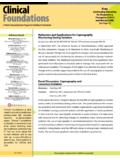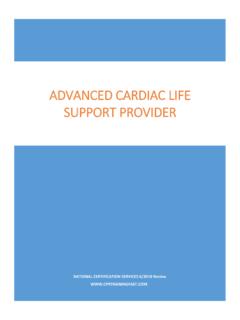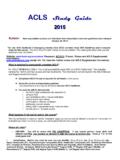Transcription of Clinical Measurements A Quick Guide to Capnography
1 Clinical MeasurementsA Quick Guide to CapnographyRecording and analysisof the CO2waveformand its use indifferential diagnosisProf. B. , Guide provides convenient viewsof a selection of CO2waveforms,along with interpretation to explaintheir relationship to other routinephysiological monitoring illustrated waveforms aresemi-schematic diagrams presentedin their ideal CO2waveformAnalyzing the CO2waveform2 Important basic rules4 The CapnogramThe normal capnogram12 Expiratory problems13 Curare capnogram14 Cardiogenic oscillations15 Camel capnogram16 Iceberg capnogram17 Leakage in the respiratory system 18 High end-tidal CO219 Low end-tidal CO223 Some disturbances of the respiratory rhythm26 Patient fights the ventilator32 Differential diagnosisSeven examples with interpretations 352 Analyzing the CO2waveformThe CO2waveform can be analyzedfor five characteristics: Height Frequency Rhythm Baseline ShapeThe normal end-tidal value isapproximately: 38 mmHg or 5%etPCO2 Height depends on the end-tidalCO2value etPCO2 Frequency depends on therespiratory rate Rhythm depends on the state ofthe respiratory center or on thefunction of the ventilator Baseline should be zero There is only one normal shape(see page 12)The CO2waveformThe waveforms are typicallyrecorded or displayed at twodifferent speeds:Real-time (high) speed at (slow) speed at 25 mm/min3 The CO2waveformA sudden dropin CO2to zero or to a low level always indicates atechnical disturbance or defect: Spontaneous breathing orventilated patients Kinked ET-tube CO2analyzer defective Ventilated patients Total disconnection Ventilator defectiveA sudden changein baseline,sometimes combined withchanges in plateau level,indicates: Calibration error CO2absorber saturated (checkcapnograph with room air) Water drops in analyzer orcondensation in airway adapterCHECK CAPNOGRAPH !
2 Basic rules5 Important basic SPEEDTREND SPEEDA sudden decreasein CO2value(but not to zero) withspontaneous or ventilatedbreathing indicates: Leakage in the respiratorysystem (low airway pressure) Obstruction (high airwaypressure)An exponential decreasein CO2(washout curve) within one ortwo minutes always indicates asudden disturbance in lungcirculation or ventilation: Circulatory arrest Embolism Sudden decrease in bloodpressure Sudden severe hyperventilation6 Important basic basic SPEEDTREND SPEEDG radual increasein CO2forspontaneous or controlledbreathing indicates: Developing hypoventilation Absorption of CO2fromperitoneal cavity (laparoscopy) Rapidly rising body temperatureSudden increasein CO2(spontaneous or controlledventilation): Injection of sodium bicarbonate Sudden release of tourniquet(legs, arms, etc.) Sudden increase in bloodpressure ( , intravenousadrenaline)8 Important basic basic SPEEDTREND SPEEDG radual upshiftin the CO2baseline andtopline can resultfrom: Saturation of CO2absorber Calibration error Technical error in CO2analyzer Increasing dead-space, resultingin re-breathing CO2absorber switched offGradual loweringof the end-tidalCO2.
3 The curve retains its normalshape but the height of theplateau falls gradually. In anartificially ventilated patient, thiscan be caused by: Gradual hyperventilation Lowering body temperature Decreasing body or basic rules11 Important basic SPEEDTREND SPEEDThe normal capnogramThere is only one normal : Rapid increase from P to Q Nearly horizontal plateau betweenQ and R (slightly sloping up to R) From R rapid decrease to zero Points P, Q, R, and S appear asrounded corners. (P, Q, R is theexpiratory phase. R, S, P is theinspiratory phase.) Slope of the plateau depends onthe condition of the airways andlung tissue End-tidal value is onlyequivalentto the alveolar CO2when a nearlyhorizontal plateau is seen12 Representative capnogramsHIGH SPEEDE xpiratory problemsIn general, any airway obstructionlimiting explanations: Kinked tube (developing out of apreviously normal shape) Foreign body Herniated cuff (developing out ofa previously normal curve) Bronchospasm Emphysema Bronchial asthma13 Representative capnogramsHIGH SPEED Curare capnogram* Caused by lack of coordinationbetween intercostal muscles anddiaphragm Note the cleft in right third of theplateau.
4 CO2mostly too high. Thedepth of the cleft is proportionalto the degree of muscle only in spontaneousrespiration, or when the patientstarts to fight the ventilator Also seen in patients with cervicaltransverse lesions* The expression curare capnogram was given at the time thatcurare was a generally accepted muscle relaxant (about 1960).Nowadays, other muscle relaxants are in use, but the shape ofthe capnographic curve in patients who are partially paralyzedis still the capnogramsHIGH SPEEDC ardiogenic oscillationsCaused by the beating of the heartagainst the lungs: Small tidal volume in combinationwith low respiratory rate At the end of a very longexpirationCan be caused by a centraldepression of the respiratory systemor by the ventilator running capnogramsHIGH SPEEDC amel capnogram Can be seen in patients in thelateral position on the operatingtable During either spontaneous orcontrolled respiration16 Representative capnogramsHIGH SPEEDI ceberg capnogramCaused by a combination of amuscle relaxant and a central actinganalgesic drug ( , morphine,fentanyl, etc.)
5 : Mixture of cardiogenic oscillationsand curare cleft (see page 14) No plateau. Low respiratory rate CO2higher than normal Seen only in spontaneousrespiration17 Representative capnogramsHIGH SPEEDL eakage in the respiratorysystemIrregularity mostly in expiratorylimb (see arrows): Shape and site of this irregularitydepend on the localization andseverity of the leak in theanesthetic system (cuff, valves,tubing, etc.). CO2could be toohigh due to hypoventilation or too low due to the addition ofleaking air Other possible leakage shapes haveto be differentiated from otherdisturbances ( , camel curve (seepage 16), etc.)18 Representative capnogramsHIGH SPEEDWith normal respiratoryrateNormal plateau but higher thannormal end-tidal CO2. Can be seenin artificially ventilated patients: When the ventilator is running atnormal respiratory rate but theminute volume is too low With primary normal respiratoryrate and minute volume but with arapidly rising body temperature( , in malignant hyperthermia)19 High end-tidal SPEEDWith bradypneaLong plateau but higher thannormal CO2.
6 Respiratorydepression without an attempt tocompensate can be seen: In cases of high ICP or respiratorydepression due to morphinic-based drugs ( , pethidine,fentanyl, etc.) In artificially ventilated patients,when the ventilator is runningwith both respiratory rate andminute volume too low20 High end-tidal SPEEDH ypoventilation withtachypneaShort plateau but higher thannormal end-tidal CO2. Respiratorydepression with an attempt tocompensate by higher respiratoryrate can be caused by: Volatile anesthetics duringspontaneous respiration ( ,halothane, etc.) Ventilator running at high rate butwith low tidal volume21 High end-tidal SPEEDVery severe hypoventilationVery severe hypoventilation (verylow tidal volume) with a highrespiratory rate as an attempt tocompensate. A misleading low levelof CO2is recorded on thecapnogram. Mostly no properplateau. After thorax compressionor forced exhalation (see arrow),true CO2value becomes visible: Can be seen under spontaneous orcontrolled breathing In patients with spontaneousrespiration but with severerespiratory paralysis caused byparalyzed respiratory muscles Malfunction of ventilator orleakage in respiratory system22 High end-tidal SPEEDWith normal respiratoryrateWith normal respiratory rate andplateau but a lower than normalend-tidal CO2.
7 Can be observed inartificially ventilated patients: When the ventilator runs with anormal rate but the minutevolume is too high Who are in shock With normal respiratory rate andtidal volume but with a low bodytemperatureCan also be seen in patients withspontaneous respiration when theyare compensating a end-tidal SPEEDWith bradypneaWith bradypnea but a lower thannormal end-tidal CO2and a longplateau in: Artificially ventilated patient whenthe ventilator is running at a lowrate and a high minute volume In patients with spontaneousrespiration with: Damage to the central nervoussystem ( , the so-called centralneurogenic hyperventilation) A low body temperature andrespiratory depression caused byanalgesics 24 Low end-tidal SPEEDWith tachypneaWith tachypnea but a lower thannormal end-tidal CO2and shortplateau: In patients on artificial ventilationwhen the ventilator is running athigh rate and with a high minutevolume In patients with spontaneousrespiration who are: In pain Trying to compensate ametabolic acidosis Hypoxic In some cases of centralneurogenic hyperventilation In severe shock conditions25 Low end-tidal SPEEDSome disturbances of therespiratory rhythmCheyne-Stokes respirationOnly seen with spontaneousrespiration.
8 Cardiac oscillations(indicated by the arrows) after everyrespiratory group. Can be seen in cases of severecerebral arteriosclerosis, braindamage, intoxication, respirationCan be seen in some patients as atransition condition betweenCheyne-Stokes and normalbreathing. Only seen with spontaneousrespiration. The tidal volumechanges regularly, hence thewaving characteristic of the upperlimit on the capnographic disturbances of therespiratory rhythm27 Gasping respiration Very low respiration rate (2-6/min) CO2mostly higher than normal Often cardiogenic oscillationsafter every capnographic curve (see arrows)Seen in very severe respiratorydepression or in dying patients28 Some disturbances of therespiratory rhythmVery irregular or chaoticrespiration No regularity All curves differ in size, shape, andheight. Average CO2level abovenormalSeen in severe cerebral damage29 Some disturbances of therespiratory rhythmSighing respiration A regular pattern with regularintervals interrupted by a deepsigh (indicated by arrows) Physiological in babies, smallchildren , and very old peopleduring sleep or when under ananesthetic Pathological in young people andadults when deep sighs are morefrequent than once in 5 indication of brain damage Average CO2level can be normal,high, or lower than normal30 Some disturbances of therespiratory also be seen in ventilatedpatients when the ventilator has anintermittent deep sigh normal lungs, the deep sigh CO2level is lower than average (A).
9 Incases of obstructive lung disease, thedeep sigh level will be higher thanaverage (B).Some disturbances of therespiratory rhythmWhen a patient starts to breathe againstthe ventilator (A), the regular pattern ofthe capnogram is interrupted. Therespiratory activity of the patientincreases quickly. The end-tidal CO2rises slightly due to the increasingmetabolism of the contractingrespiratory created by the ventilator (B).Capnogram created through theattempted spontaneous respiration ofthe patient (C). During an anesthetic this capnogramindicates that another dose of musclerelaxant should be given to the patient32 Patient fights the ventilatorNote:Combinations of the waveformsdiscussed up to this point are alwayspossible. Results depend on theclinical condition of the patient andthe technical status of theinstrumentation iceberg capnogram is anexample of a combinationwaveform. (see page 17)33 Differential diagnosisCorrect interpretation of the manypossible capnographic curves canonly be achieved by comparisonwith other parameters recordedsimultaneously.
10 This makes adifferential diagnosis parameters for this purposeare: ECG/heart rate Blood pressure (direct or indirect) Body temperature Plethysmogram (taken from theearlobe or finger) PaCO2 PaO2 Airway pressure Central venous pressure Acid-base status35 Differential diagnosisExample 1 ECG: disappears, no heart rate Pleth: becomes a straight line Blood pressure: drops Capnogram: no changeInterpretation:Technical defect when the vital signs monitor (ECG, pleth, bloodpressure) and the capnograph are separate is not in danger. Without proper circulation a normal capnogramis not 2 Controlled respiration, temperature 37 C ECG: normal Pleth: normal Blood pressure: constant Capnogram: rapid decrease in CO2 Possible interpretations: Considerable leakage in the respiration IN DANGER Technical disturbance in capnograph. Patient not in dangerDifferential diagnosis: Check airway pressure Check capnograph with own expiratory air (always around 38 mmHg or 5%)3940 Example 3 ECG: increased heart rate, occasional PVCs Pleth: diminishing amplitude and irregularities in amplitude Blood pressure: increasing Capnogram: CO2level risesPossible interpretations: Adrenaline intoxication ( , local anesthesia) Effect from manipulating a pheochromocytoma Effect from painful stimulus Patient awakes PATIENT POSSIBLY IN DANGER41 PVCs42 Example 4 ECG: asystole, after some PVCs Pleth: diminishing amplitude developing into a straight line Blood pressure: drops to zero Capnogram: washout curve.







